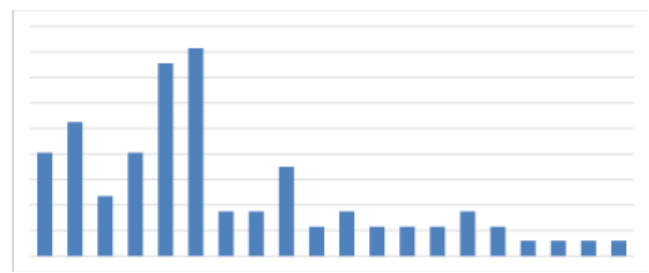Patterns and outcomes of Caesarean Sections in a private hospital, Southeast Nigeria: A 2-year retrospective review
Main Article Content
Abstract
Background: Caesarean Section (C/S) is done to end labour when the health of mother and or baby is in danger. Reports of C/S in Nigeria come from public tertiary hospitals. The aim of this study is to appraise caesarean sections done in a private hospital southeast Nigeria, and contribute to knowledge.
Materials and methods: This is a retrospective study of age, type of C/S, indications, outcomes, normal vaginal deliveries and C/S from January 1, 2021 to December 31, 2022. Data analysis was done with IBM SPSS version 20. Z test and 2 were used to summarize characteristics of variables. Values with P < 0.05 were taken as significant.
Results: There were 381 deliveries in 2021, 30 (7.87%) were by C/S and 410 in 2022, 56 (13.66%) were by C/S. The rise in rate of C/S is significant, p = 0.008. The total deliveries within the period of study is 791 and 86 were by C/S giving an overall rate of 10.87%. Mother’s mean age was 30.58 ± 5.28 years and age range is 20 to 48 years. The most common indication for C/S was prolonged labour followed by obstructed labour, and 2 or more previous scars. Cephalo-pelvic disproportion and foetal distress came fourth. There was 1 maternal death giving a case fatality rate of 1.16%. There were 5 foetal loses, 2 of which were intrauterine deaths before the surgery and 3 were fresh still births. Most common postoperative complication was wound sepsis that occurred in 4 cases (4.7%). There is no difference in outcome of elective and emergency C/S, p = 0.366.
Conclusion: C/S rate is within the rate recommended by the WHO. Most common indication for C/S is a combination of prolonged and obstructed labour. Most C/S come as emergency. There is no difference in outcome of emergency and elective C/S
Downloads
Article Details
Section

This work is licensed under a Creative Commons Attribution-NonCommercial-ShareAlike 4.0 International License.
How to Cite
References
Young JH. Caesarean Section: The History and Development of the Operation from Earliest Times. YoungJH_1942redux.pdf
Caesarean section on the rise. Lancet. 2000 Nov 18;356(9243):1697. PMID: 11095250.
Althabe F, Sosa C, Belizán JM, Gibbons L, Jacquerioz F, Bergel E. Cesarean section rates and maternal and neonatal mortality in low, medium, and high-income countries: An ecological study. Birth. 2006; 33:270–277.
Penn Z, Ghaem-Maghami S. Indications for caesarean section. Best Pract Res ClinObstetGynaecol. 2001;15(1):1-15.
WHO. Appropriate technology for birth. Lancet 1985;2:436–7.
WHO. WHO Statement on Caesarean Section Rates. Geneva: World Health Organization. Geneva. 2015.
Gibbons L, Belizán JM, Lauer JA, et al. The global numbers and costs of additionally needed and unnecessary caesarean sections performed per year: overuse as a barrier to universal coverage. World health report. 2010;30:1–31.
Gibbons L, Belizan JM, Lauer JA, et al. Inequities in the use of cesarean section deliveries in the world. Am J Obstet Gynecol. 2012;206(4):331.e1–331.e19. e1-31. e19
Betrán AP, Ye J, Moller AB, et al. The Increasing Trend in Caesarean Section Rates: Global, Regional and National Estimates: 1990-2014. PLoS One. 2016;11:e0148343.
National Population Commission (NPC) [Nigeria] and ICF International. Nigeria Demographic and Health Survey 2008. Abuja, Nigeria and Rockville, Maryland, USA: NPC and ICF International, 2009.
National Population Commission (NPC) [Nigeria] and ICF International. Nigeria Demographic and Health Survey 2013. Abuja, Nigeria and Rockville, Maryland, USA: NPC and ICF International, 2014.
Adewuyi EO, Auta A, Khanal V, TapshakSJ, Zhao Y. Cesarean delivery in Nigeria: prevalence and associated factors―a population-based cross sectional study. BMJ Open. 2019;9:e027273. doi:10.1136/ bmjopen-2018-027273.
Isah AD, Adewole N, Zaman J. A five‑year survey of cesarean delivery at a Nigerian tertiary hospital. Trop J ObstetGynaecol. 2018;35:14‑7.
John CO, Alegbeleye JO. Caesarean Delivery at a Teaching Hospital, South-South Nigeria: A Five-Year Review. IJTDH. 2017;21(2): 1-6.
Eleje GU , Udigwe GO , Akabuike JC , Eke AC , Eke NO , 1Umeobika JC. The Rate of Caesarean Section in Nnewi, Nigeria: A 10-year Review. Afrimedic Journal. 2010; 1(1):11-14.
Hilekaan SK, Ojabo A, Idogah S. Caesarean Section Rate in a Tertiary Hospital in Makurdi, North-Central Nigeria. Gen Med (Los Angel) 2015, 3:3 DOI: 10.4172/2327-5146.1000183.
Daniel CN, Singh S. Caesarean delivery: An experience from a tertiary institution in North Western Nigeria. Niger J Clin Pract. 2016;19:18-24.
IBM Corp. Released 2011. IBM SPSS Statistics for Windows, Version 20.0. Amork, NY:IBM Corp.
WHO. Trends in Maternal Mortality: 1990 to 2008. Geneva: World Health Organization. 2010.
Zwecker P, Azoulay L, Abenhaim HA. Effect of fear of litigation on obstetric care: A nationwide analysis on obstetric practice. Am J Perinatol. 2011;28:277-84.
Hellerstein S, Feldman S, Duan T. China’s 50% caesarean delivery rate: Is it too high? BJOG. 2015;122:160-4.
Abdel-Aleem H, Shaaban OM, Hassanin AI, Ibraheem AA. Analysis of cesarean delivery at Assiut University Hospital using the Ten Group Classification System. Int J Gynaecol Obstet. 2013;123:119-23.
Torloni MR, Betrán AP, Montilla P, Scolaro E, Seuc A, Mazzoni A, et al. Do Italian women prefer cesarean section? Results from a survey on mode of delivery preferences. BMC Pregnancy Childbirth. 2013;13:78.
Angeja AC, Washington AE, Vargas JE, Gomez R, Rojas I, CaugheyAB. Chilean women’s preferences regarding mode of delivery: Which do they prefer and why? BJOG. 2006;113:1253-8.
Torloni MR, Daher S, Betrán AP, Widmer M, Montilla P, Souza JP, et al. Portrayal of caesarean section in Brazilian women’s magazines: 20 year review. BMJ. 2011;342:d276
Osonwa OK1, Eko JE, Ekeng P E. Trends in Caesarean Section at Calabar General Hospital, Cross River State, Nigeria. European Journal of Biology and Medical Science Research. 2016;4(1):1-5.
Eleje GU, Ugwu EO, Enebe JT, et al. Cesarean section rate and outcomes during and before the first wave of COVID-19 pandemic. SAGE Open Medicine. 2022;10. doi:10.1177/20503121221085453
Birth After Previous Caesarean Birth. Royal College of Obstetricians and Gynaecologists (RCOG). Green-Top Guideline No. 45; February, 2007: 393409.
WHO, UNFPA, UNICEF and Mailman School of Public Health. Monitoring Emergency Obstetric Care. Geneva, Switzerland: World Health Organization. 2009. ISBN 9789241547734.






